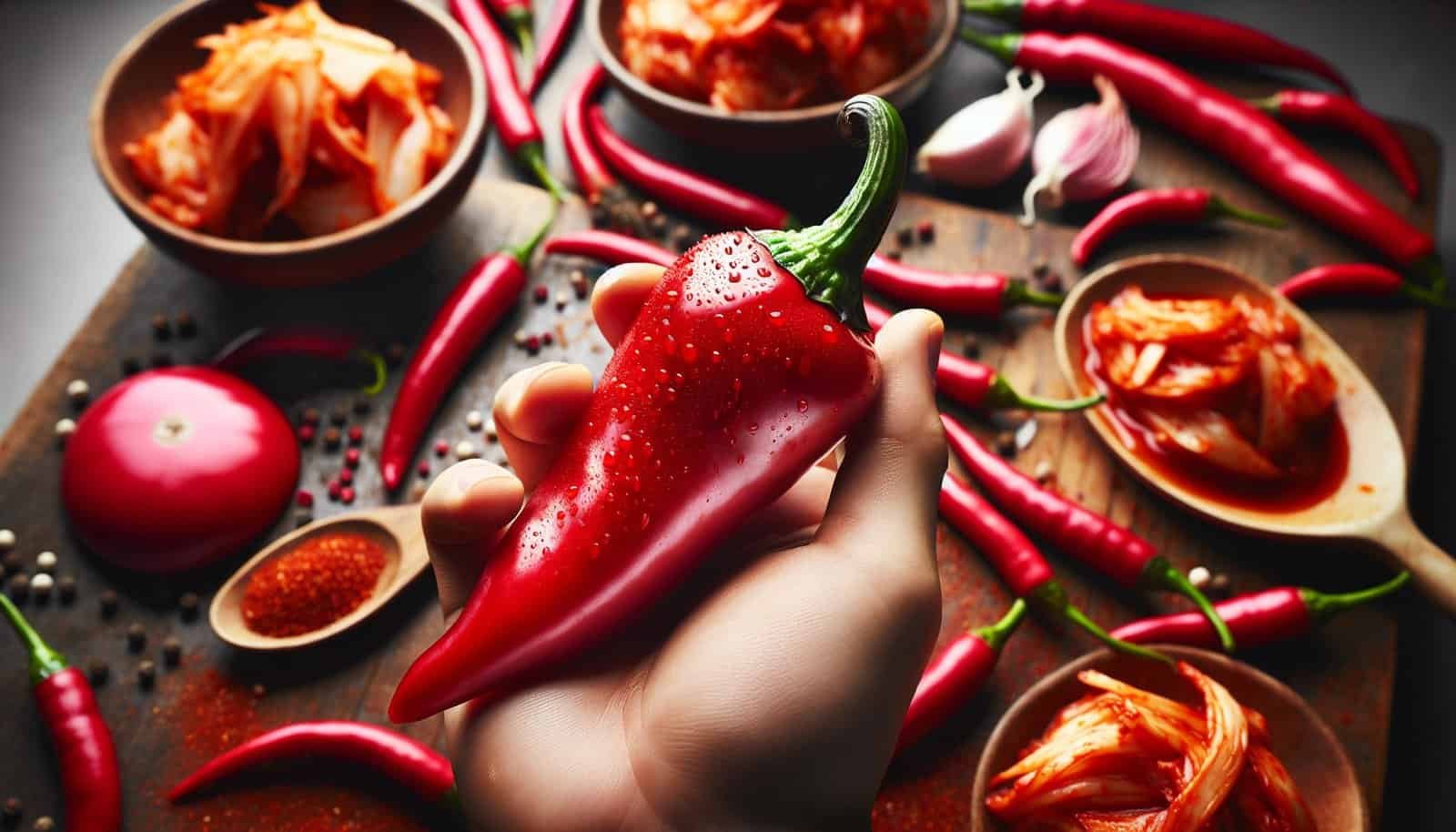You’re about to discover the secrets to making authentic and delicious kimchi in the comfort of your own home. This article will guide you through the key steps that will ensure your kimchi is bursting with flavor and captures the true essence of this traditional Korean dish. Get ready to embark on a culinary adventure as you learn the art of fermenting cabbage, creating the perfect spice blend, and achieving the ideal balance of flavors. With these easy-to-follow steps, you’ll soon be impressing your friends and family with your homemade kimchi prowess. Get your apron on and let’s dive into the world of kimchi-making!

Choosing the Right Cabbage
Selecting Napa Cabbage
When it comes to making homemade kimchi, choosing the right cabbage is crucial. Napa cabbage is the most popular and widely used variety for kimchi due to its mild and crisp flavor. Look for heads of Napa cabbage that are firm, compact, and heavy for their size. The leaves should be fresh and free from any signs of wilting or discoloration. Additionally, opt for cabbages with tightly closed and sturdy outer leaves as they will be used to wrap the kimchi during the fermentation process.
Alternative Cabbage Options
While Napa cabbage is the traditional choice for kimchi, you can also experiment with other cabbage varieties to create unique flavors and textures. Savoy cabbage, with its crinkled and ruffled leaves, can add a bit of complexity to your kimchi. Bok choy, with its delicate and tender stalks, can lend a subtle sweetness. Red cabbage, besides imparting vibrant colors to your kimchi, provides a slightly earthier taste. Don’t be afraid to mix different cabbage varieties to customize your kimchi according to your taste preferences.
Preparing the Cabbage
Cleaning the Cabbage
Before you can start making kimchi, it is important to thoroughly clean your cabbage to remove any dirt or impurities. Begin by removing any damaged or wilted outer leaves. Then, rinse the cabbage under cold running water, making sure to rinse between the leaves to remove any hidden debris. For extra precaution, you can also soak the cabbage in a large bowl of water, gently swishing it to dislodge any remaining dirt. After rinsing, allow the cabbage to fully drain before proceeding to the next step.
Salting and Soaking the Cabbage
Salting and soaking the cabbage is a crucial step in kimchi preparation as it helps to create the perfect texture and flavor. Cut the cabbage into quarters lengthwise and remove the core. Sprinkle salt generously between the leaves, ensuring that each leaf gets coated. Allow the cabbage to rest for about two hours, flipping it halfway through, to allow the salt to draw out excess moisture. After the salting process, rinse the cabbage under cold water to remove the excess salt. This step ensures that the kimchi isn’t overly salty and also helps to maintain the crunchiness of the cabbage.
Preparing the Kimchi Paste
Gathering Ingredients
To make the flavorful kimchi paste, you will need a variety of ingredients. The essential components include gochugaru (Korean red pepper flakes), garlic, ginger, fish sauce, and a sweetener such as sugar or honey. These ingredients form the core of kimchi’s signature taste. You can also experiment with additional spices and ingredients such as soy sauce, pear juice, or even apple to add complexity and depth to your kimchi. Gathering all the necessary ingredients beforehand will ensure a smooth and efficient kimchi-making process.
Mixing the Paste
Once you have gathered all the ingredients, it’s time to mix them together to create the kimchi paste. Start by finely mincing the garlic and ginger. In a bowl, combine the minced garlic and ginger with gochugaru, fish sauce, and the sweetener of your choice. Mix everything together until well combined, ensuring that the gochugaru coats all the other ingredients evenly. The resulting paste should have a vibrant red color and a fragrant aroma. Adjust the seasoning if necessary, adding more gochugaru for spiciness or more sweetener for a milder flavor. Remember, the paste is the heart of your kimchi, so make sure it is well-balanced and to your liking.
Adding Seasonings and Vegetables
Choosing Seasonings
Besides the kimchi paste, various seasonings can be added to enhance the flavor complexity of your kimchi. Some traditional options include sliced scallions, grated daikon radish, and Korean salted shrimp. These seasonings contribute both to the taste and texture of the kimchi. You can also experiment with additional ingredients such as carrots, onions, or even fruits like pineapple to create your own unique twist on traditional kimchi. Be creative and have fun exploring new flavor combinations to personalize your kimchi recipe.
Incorporating Vegetables
Once you have prepared your kimchi paste and selected the seasonings, it’s time to incorporate them into the cabbage. Take each quartered cabbage and spread a generous amount of the kimchi paste between each leaf. Make sure to thoroughly coat the cabbage, ensuring that the paste reaches deep into the layers. For the added seasonings, place them in between the leaves as well. This will allow the flavors to infuse and create a harmonious blend. If you’re using additional vegetables, thinly slice or shred them before layering for even distribution. It’s important to evenly distribute the seasoning and vegetables for consistent flavor throughout your kimchi.

Fermenting the Kimchi
Layering and Packing Kimchi
After adding the seasonings and vegetables, it’s time to layer and pack the kimchi into a container. Take each quartered and seasoned cabbage and stack them neatly in a large glass or ceramic container. Pack them tightly, pressing down firmly to eliminate any air pockets. It’s important to pack the kimchi tightly to ensure even and consistent fermentation. As you pack the kimchi, you may notice that the moisture from the cabbage and the paste begins to accumulate in the bottom of the container. This liquid is known as the kimchi brine and is an essential component of the fermentation process.
Creating the Optimal Fermentation Environment
To successfully ferment your kimchi, you need to create the ideal environment for the beneficial bacteria to thrive. Temperature, humidity, and time play crucial roles in the fermentation process. The optimum temperature for kimchi fermentation is around 60 to 70 degrees Fahrenheit (15 to 21 degrees Celsius). However, it’s important to note that the fermentation process is slower at lower temperatures and faster at higher temperatures. To maintain the ideal humidity level, cover the container with a loose-fitting lid or plastic wrap, allowing gases to escape while preventing dust or insects from entering. Now, place the container in a dark and cool location, such as a pantry or basement, and let the kimchi ferment for at least two to three days before moving it to cold storage.
Storing and Aging Kimchi
Determining the Ideal Storage Time
Once the initial fermentation is complete, it’s time to store and age your kimchi. The optimal storage time will depend on your personal preference for taste and texture. To enjoy a fresher and milder kimchi, store it in the refrigerator after the initial fermentation period. This will slow down the fermentation process and preserve the flavors. However, if you prefer a more robust and tangy kimchi, let it continue to age at room temperature for a longer period, typically around one to four weeks. Remember to periodically taste your kimchi during the aging process to find the perfect balance of flavors and determine the ideal storage time for your personal taste.
Proper Storage and Aging Techniques
When storing and aging kimchi, it’s important to keep it in an airtight container to prevent exposure to air, which can lead to spoilage. Glass jars with airtight lids or food-grade plastic containers are both suitable options. Make sure to pack the kimchi tightly, removing any air bubbles, and cover it with a small amount of the kimchi brine produced during fermentation. This brine helps to maintain the kimchi’s flavor and prevents it from drying out. Store the container in the refrigerator for a fresher kimchi or continue to age it at room temperature, periodically burping the container to release built-up gases. Remember that the flavors of the kimchi will continue to develop and change over time, so experimentation with storage and aging techniques can lead to diverse and exciting flavors.

Serving and Enjoying Kimchi
Pairing with Different Dishes
Kimchi is a versatile condiment that can be enjoyed in a variety of ways. Its vibrant flavors make it a perfect accompaniment to numerous dishes. Serve kimchi alongside a traditional Korean meal, such as bibimbap or bulgogi, to add a spicy and tangy kick. Use it as a topping for noodles, rice, or salads to add depth and complexity. Incorporate kimchi into sandwiches, wraps, or tacos for a unique twist. You can even use it as a filling for dumplings or pancakes to create a fusion of flavors. The possibilities are endless, so don’t be afraid to experiment and incorporate kimchi into your favorite dishes.
Exploring Various Kimchi Recipes
While the traditional cabbage kimchi is the most well-known, the world of kimchi is vast and diverse. There are numerous variations and recipes to explore, each with its unique combination of vegetables, seasonings, and spices. Expand your kimchi repertoire by trying different types of kimchi, such as radish kimchi (kkakdugi) or cucumber kimchi (oi sobagi). Experiment with the level of spiciness, sweetness, or tanginess to find your preferred flavor profile. With so many different kimchi recipes available, you’ll never run out of new and exciting flavors to discover.
Troubleshooting and Tips
Common Kimchi Issues
While making kimchi at home is a fun and rewarding experience, you may encounter a few challenges along the way. Here are some common issues and how to address them:
Soft or slimy cabbage: This can be caused by the cabbage being over-fermented. To avoid this, decrease the fermentation time or adjust the temperature.
Unpleasant or off-flavors: The kimchi paste may have been too salty or fermented for too long. Adjust the amount of salt in the paste and reduce the fermenting time for a milder flavor.
Mold growth on the surface: Mold can occur if the kimchi is exposed to air or if unsanitary conditions were present during preparation. Ensure that the container and utensils are thoroughly clean, pack the kimchi tightly, and use an airtight lid or plastic wrap to prevent air exposure.
Helpful Tips for Success
To ensure the best possible outcome when making kimchi, here are some useful tips and tricks:
Use gloves when mixing the kimchi paste to avoid irritations from the gochugaru or other spicy ingredients.
The fermentation process can produce strong odors. To prevent strong odors from permeating your refrigerator, consider using a dedicated kimchi refrigerator or placing the kimchi in an airtight container within the refrigerator.
While kimchi can be enjoyed immediately after fermenting, it is often tastier after aging for a few days. Allow the flavors to develop and mellow for a more well-rounded taste.
Remember, kimchi is a living food that continues to ferment even in cold storage. Burp the container periodically to release built-up gases and prevent any explosive results.

Health Benefits of Kimchi
Nutritional Value
Kimchi not only tantalizes the taste buds but also offers an array of health benefits. It is a rich source of vitamins A, B, and C, providing essential nutrients to support immune function and promote healthy skin. Kimchi is also packed with beneficial bacteria that aid in digestion and support gut health. Additionally, it contains high levels of dietary fiber, which can help regulate blood sugar levels, promote satiety, and support healthy weight management. Incorporating kimchi into your diet can be a delicious way to boost your nutritional intake.
Potential Health Effects
Beyond its nutritional value, kimchi is believed to possess various health benefits. The combination of fermented cabbage and the kimchi paste’s ingredients provides powerful antioxidants that may help reduce inflammation in the body. Some studies suggest that kimchi may have anticancer properties, although more research is needed to fully understand its potential. The beneficial bacteria found in kimchi also contribute to maintaining a healthy gut microbiome, which has been linked to improved mental health and overall well-being. While it is essential to enjoy kimchi as part of a balanced diet, its potential health effects make it a valuable addition to any culinary repertoire.
Kimchi Variations
Regional and Cultural Variations
Kimchi is not limited to a single recipe or style. Just as every culture has its own unique cuisine, various regions and countries have their take on kimchi. From South Korea’s traditional baechu kimchi made with Napa cabbage to the spicy and piquant kimchi of North Korea, each region’s kimchi is a testament to the diversity of flavors and techniques. The use of local ingredients and the influence of regional culinary traditions create countless variations of kimchi. Exploring the regional differences provides an opportunity to experience the rich cultural heritage and culinary artistry associated with this beloved Korean dish.
Creative Kimchi Adaptations
The versatility of kimchi opens the door to a world of culinary creativity. While it may be tempting to stick to traditional recipes, don’t be afraid to experiment and adapt kimchi to suit your preferences or ingredients on hand. Consider adding unique flavors such as herbs, spices, or even fruits to create a fusion of flavors. Use kimchi as a marinade for meats, fish, or tofu to impart its signature taste in new and exciting ways. You can even incorporate kimchi into non-traditional dishes like pasta, stir-fries, or pizza to introduce a burst of umami and heat. Let your imagination run wild and create a kimchi variation that is uniquely yours.
In conclusion, making authentic and delicious kimchi at home involves a series of key steps. From choosing the right cabbage and preparing it through salting and soaking, to creating the flavorful kimchi paste and incorporating seasonings and vegetables, each step is essential in creating a mouthwatering kimchi. Proper fermentation and storage techniques ensure that the kimchi develops its characteristic tangy and spicy flavor while maintaining its nutritive value. Serving and enjoying kimchi can be a delightful culinary adventure, with numerous pairing options and recipes to explore. With an understanding of the health benefits of kimchi and the sheer variety of kimchi variations available, you can embark on a journey of kimchi-making that is as exciting as it is delicious. So go ahead, gather the ingredients, follow the steps, and savor the flavors of homemade kimchi!

